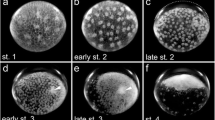Abstract
Shortly after initiation of Dictyostelium fruiting body formation, prespore cells begin to differentiate into non-motile spores. Although these cells lose their ability to move, they are, nevertheless, elevated to the tip of the stalk. Removal of the amoeboid anterior-like cells, located above the differentiating spores in the developing fruiting body, prevents further spore elevation although the stalk continues to elongate. Furthermore, replacement of the anterior-like cells with anterior-like cells from another fruiting body largely restores the ability to lift the spores to the top of the stalk. However, if amoeboid prestalk cells are used to replace the anterior-like cells, there is no restoration of spore elevation. Finally, when a droplet of mineral oil replaces differentiating spores, it is treated as are the spores: the mineral oil is elevated in the presence of anterior-like cells and becomes arrested on the stalk in the absence of anterior-like cells. Because a similar droplet of mineral oil is totally ignored by slug tissue, it appears that there is a dramatic transformation in the treatment of non-motile matter at this point in Dictyostelium development.
Similar content being viewed by others
Author information
Authors and Affiliations
Additional information
Received: 26 January 1998 / Accepted: 27 May 1998
Rights and permissions
About this article
Cite this article
Sternfeld, J. The anterior-like cells in Dictyostelium are required for the elevation of the spores during culmination. Dev Gene Evol 208, 487–494 (1998). https://doi.org/10.1007/s004270050207
Issue Date:
DOI: https://doi.org/10.1007/s004270050207




